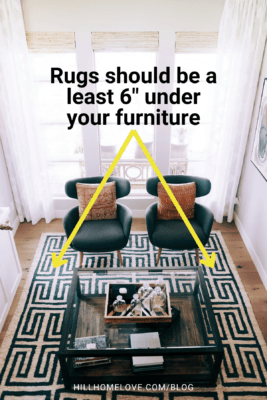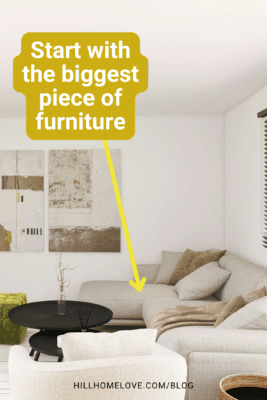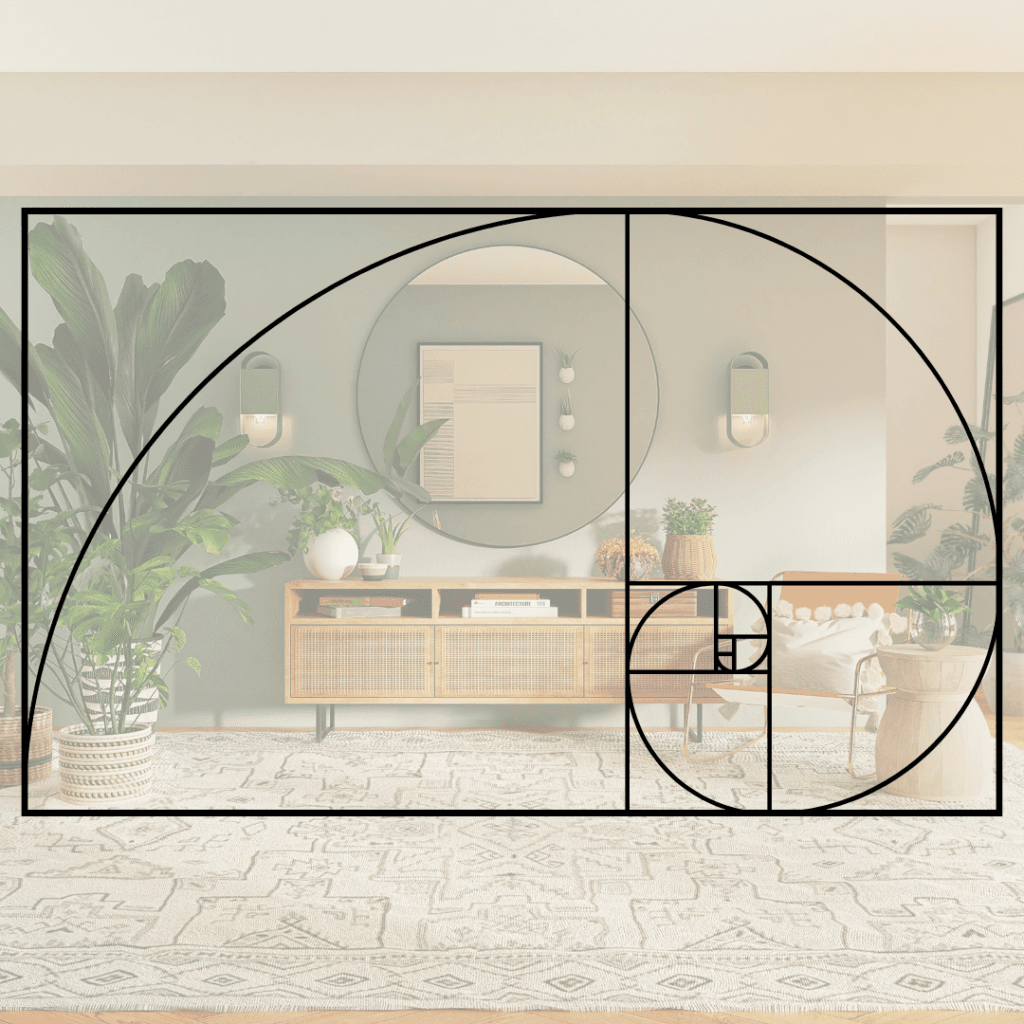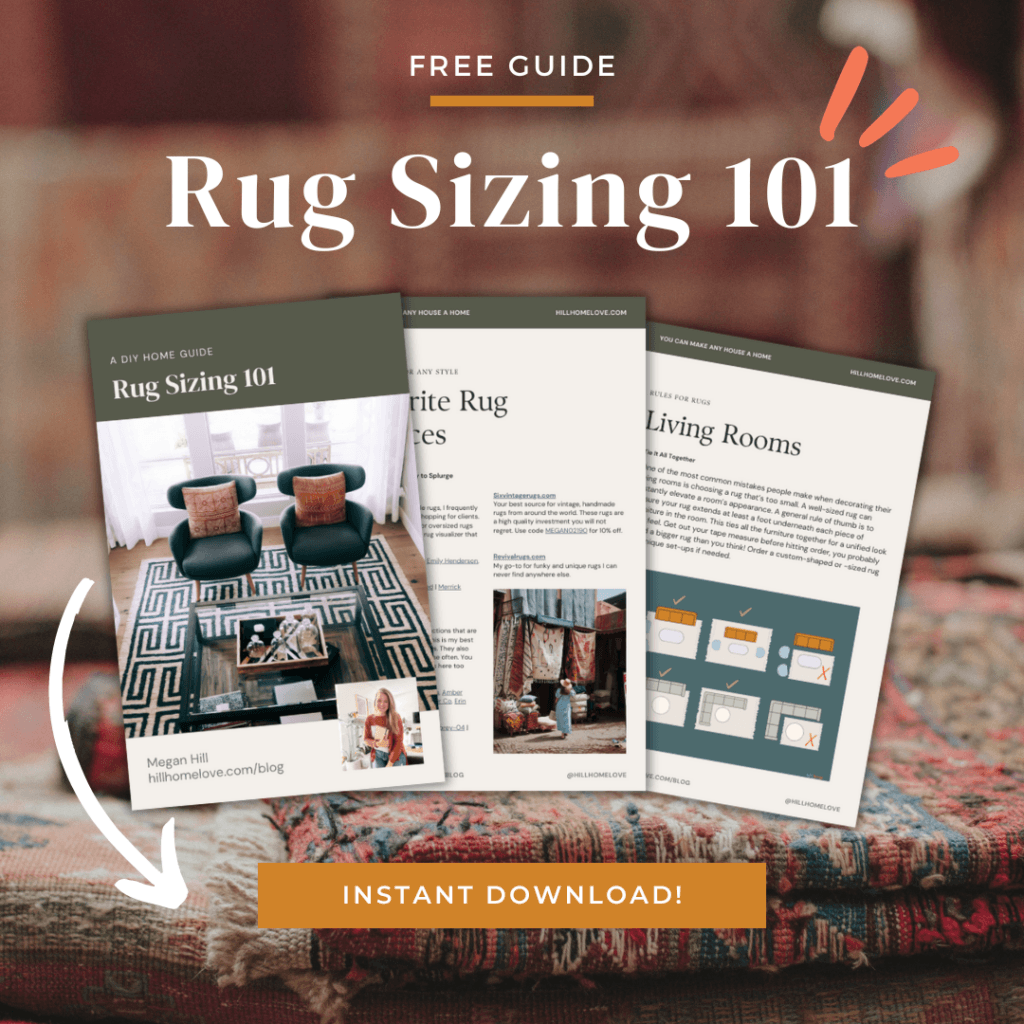Today I’m sharing a handful of practical interior design tips to help you get started in your new (or old!) home. As a new homeowner, you’ll probably be making lots of purchasing and spending your weekends furnishing and decorating your new digs. These interior design tips will walk you through everything from finding your style to creating an adequate lighting plan.

- Tip #1. Use symmetry in your bedroom decor.
- Tip #2. Try the Odd Number Rule of Decorating.
- Tip #3. Recreate the Rule of Thirds: The Golden Ratio.
- Tip #4. Don't skimp on the rug.
- Tip #5. Interior design tips for curtain height.
- Tip #6. Use three layers of lighting.
- Tip #7. The best paint sheens for walls, trim, cabinets, and more.
- Tip #8. Create a color scheme for your home.
- Tip #9. Every room needs a focal point.
- Tip #10. Start a room design with the largest piece of furniture.
- Tip #11. Determine your general style and stick to it.
- Tip #12. Consider your home's architecture style.
- Tip #13. Functionality comes first.
- More Interior Design Tips To Consider
Tip #1. Use symmetry in your bedroom decor.
The use of symmetry in a bedroom design is like a secret weapon for creating a calm and balanced space.
By placing furniture and decor in a way that mirrors each side of the room, you can instantly make the area feel more organized and peaceful.
Imagine walking into your bedroom and seeing matching nightstands on either side of the bed, or identical lamps casting a warm, inviting glow.
This sense of harmony not only pleases the eye but also helps create a restful environment where you can truly relax and unwind.
Tip #2. Try the Odd Number Rule of Decorating.
The odd number rule of decorating is a simple trick that can make your space feel more visually interesting and dynamic.
When you group items like candles, picture frames, or vases in odd numbers—think sets of three or five—it creates a little vignette (or scene) that draws the eye in.
Unlike even-numbered groupings, which can feel a bit too balanced or predictable, odd numbers add just the right amount of visual tension and make your decor stand out.
So, next time you’re arranging your favorite pieces, try grouping them in threes for a more stylish, designer-approved look.
Tip #3. Recreate the Rule of Thirds: The Golden Ratio.
The golden ratio, represented by the number 1.618, is a mathematical principle that’s been used for centuries in art, architecture, and design to create visually pleasing compositions.
In interior design, it’s all about achieving a sense of balance and proportion. When you apply the golden ratio, you divide your space or elements within it into a ratio of approximately 60/40.
This means that for a room, you might allocate 60% of the space to one function or design element, like a sofa, and the remaining 40% to complementary items, such as chairs or a coffee table.
This ratio naturally guides the eye through the room in a way that feels balanced and harmonious, making the overall design more aesthetically satisfying.
As far as interior design tips go, this one might feel a little more allusive. But by aligning your decor with this principle, you can create spaces that are not only beautiful but also intuitively comfortable to be in.







Tip #4. Don’t skimp on the rug.
One of the biggest home design mistakes you can make is choosing the wrong size rug. A rug makes a huge impact in a room!
Unfortunately, I’ve seen a lot of designers boldly claim things like “always buy an 8×10 rug for a bedroom” or “a 10×14 rug works best for a living room.”
But I completely disagree. It all depends on your unique set-up.
Following a general rule could result in spending your hard-earned budget on the totally wrong rug for your space.
So I created a Rug Sizing 101 Guide to walk you through exactly how to order the right size rug every time.
And as a bonus, I’m sharing an exclusive list of my favorite rug brands and go-to shops—something I’ve never shared before!

Want to know a designer secret? Get my insider tips on how to order the right size rug every single time.
Tip #5. Interior design tips for curtain height.
Curtains have the power to make your space feel taller and more open. To achieve this, it’s all about placement. Hanging your curtains above your window frame can make them look larger.
Hang them at least 6 inches above the window if you can, more is even better.
The exact height of your curtain rod is more of a preference (although there is some visual strategy involved!), but my non-negotiable curtain rule is this: make sure your curtains touch the floor!!
This matters because it creates layers that are really important in your room. It’s a visual connection between the wall and the floor. Too short and suddenly the wall feels shorter too.
For width, extend the rod 6 to 12 inches beyond the window on each side to give the illusion of larger windows and let in more natural light.
Tip #6. Use three layers of lighting.
Another common issues I see in client’s homes is inadequate lighting.
You need 3 layers of lighting in every room: ambient lighting, accent lighting, and task lighting. This helps your home feel bright and comfortable at every time of day.
- Task lighting is direct lighting for specific functions. This is illuminates a small area and makes a task easier to accomplish. Such as a lamp near a couch for reading, under-cabinet lights in a kitchen for food prepping, or a desk lamp for doing paperwork.
- Ambient lighting is the primary source of light in a room. This is your general overhead lighting that is located centered in the room. This lights up the room so that you can safely and easily navigate it.
- Accent lighting lights up all the shadows that ambient lighting can’t reach. These are places like fireplaces, corners, bookshelves, reading nooks, etc. This type of lighting can also highlight a feature in your home like artwork, decor, or an architectural detail like a fireplace. A lamp or wall-sconce are usually used for accent lighting.
Make sure your ceiling lights are 7ft or higher from the ground. This way even your tall friends will feel comfortable navigating around your house.
Also consider the type of light shade. Exposed bulbs like Edison bulbs can be very stylish, but might be much too bright for a bed-side reading light or a dining light.
Shades or frosted glass can create a more muted, cozy light. It all depends on your style and what you like.
Tip #7. The best paint sheens for walls, trim, cabinets, and more.
A good rule of thumb for choosing paint sheens is the higher the gloss content, the easier it cleans. Gloss acts as a protectant against moisture and dirt.
But higher gloss contents also create reflections and show wall imperfections more easily.
So here are my tested-and-tried interior design tips for paint sheens in a home:
- Gloss/Semi-Gloss: Trim & Cabinets
- Satin: High-traffic or high-mess areas like hallways, kitchens, bathrooms, and closets
- Eggshell/Flat: Low-traffic areas like bedrooms, living spaces, and offices
For walls that need to be tougher against dirt, mess, and food, try to use a satin paint. Being able to quickly wipe down those walls will save you a lot of headache.
I prefer using flat paint in living rooms, offices, and bedrooms because it hides the wall texture and doesn’t cast light reflections. It’s more muted and soft than glossy paint. Less dorm-apartment vibes, and more comfortable-home vibes.
If you want to paint your trim the same color as your walls, just use a semi-gloss/gloss sheen for your trim, and choose a flat sheen for your walls to add textural contrast between them.
Tip #8. Create a color scheme for your home.
I used 18 different paint colors in our 1300sqft home in Texas. And it didn’t feel busy or chaotic!
This was possible because I created a home color scheme! I created a curated set of colors that I loved and made sure that every room in the house fit within my color scheme.
So each individual space, although unique in color, still felt connected to our home overall.
Pick 4-5 main paint colors to use in your home. Pair those with a handful of accent colors and neutral colors too.
Tip #9. Every room needs a focal point.
A focal point is the first place your eyes go when you walk in to a room, and everything else in the room gets designed around it.
Usually this is around something like a fireplace or a headboard in a bedroom. It could also be a set of windows or an interesting wall treatment.
Every room should have a focal point! If you live in a modern home with no “natural” focal point, you get to create one yourself.
Use decor or furniture, or add an architectural element like a wall treatment to draw your eye to one wall first.







Tip #10. Start a room design with the largest piece of furniture.
I’ve noticed over the years that I tend to start mood boards and room designs around ONE big element. It could be a focal point like a fireplace. Or a major piece of furniture like a couch or a rug.
I’ve found this helps me keep that one element the center of attention, and everything else naturally has to coordinate with it.
You may have a different design process, and that’s okay. Maybe you’re inspired by a specific paint color or a decor item instead, and you design the room around that first.
Whatever your process, choosing one or two elements to design a room around will help you create a cohesive design you’ll love.
Tip #11. Determine your general style and stick to it.
You’ll probably be making lots of purchases to furnish and style your new home. In my work with clients, I have found it can be really hard to determine and communicate what you like and why!
But it’s one of the most important steps in the design process. Before spending money on big purchases like furniture and decor, make sure you know styles what you like.
If you don’t know your general style yet, this is what I teach my clients, using Pinterest.
- Create a new board on your Pinterest profile. Pin anything and everything home-related to it that you inspires you and looks beautiful.
- Next, go back and review your pins.
- Look for patterns in color, prints, and even shapes within the furniture, lights, materials, and decor that you see.
Here are a few good questions to ask that can help:
- Do I see more minimal style or a more maximalist style?
- What colors are represented: bolds, neutrals, earthy colors? something else?
- Lots of old things or new, modern pieces?
- Dark and moody, or light and bright?
Write these observations down and try to identify what you like about these pins. Let these observations set the tone and direction for anything you purchase for your home from now on.
This is a helpful exercise to show you what you love within your particular design style.
You can come back and repeat this whenever your style changes, you move to a new home, or you feel unsure of how to decorate your home.
Tip #12. Consider your home’s architecture style.
When furnishing and decorating your home, it’s crucial to keep its architectural style in mind.
Whether your home has a mid-century modern vibe, classic colonial charm, or industrial loft details, aligning your decor with its structural design creates harmony and flow.
This doesn’t mean everything has to match perfectly—mixing in personal touches and styles is great—but honoring the architecture will help your space feel cohesive and intentional. It’s about enhancing the features that make your home unique while reflecting your own style.
If you live in a modern American home and feel it has no architectural style, you have some freedom here.
Lean into a style you love and add that into your home through decor, wall treatments, flooring, etc.
Tip #13. Functionality comes first.
When it comes to home design, putting functionality first is key to turning your new home into a space that truly works for you.
Before diving into color schemes or decor, think about how you’ll use each room on a daily basis.
For example, if your living room is where you relax, entertain, and maybe even work from home, you’ll want to prioritize comfortable seating, good lighting, and smart storage solutions.
By focusing on how a space functions, you ensure that your home not only looks great but also meets your everyday needs.
This practical approach helps you avoid common pitfalls like buying furniture that’s more flashy than practical, or prioritizing decor over essential storage opportunities.
My friend Emily talks a lot about functionality in home design. I always learn something new from her!
More Interior Design Tips To Consider
I hope these interior design tips will get you started in your new home. I write about interior design tips and DIY tutorials on a weekly basis here! If these were helpful, take a look around at some other posts.
- 21 Ways To Brighten A Dark Kitchen
- When to Invest vs. When To Save with Furnishings
- How To Achieve Balance In Your Home’s Design
Please share this post with a friend!






